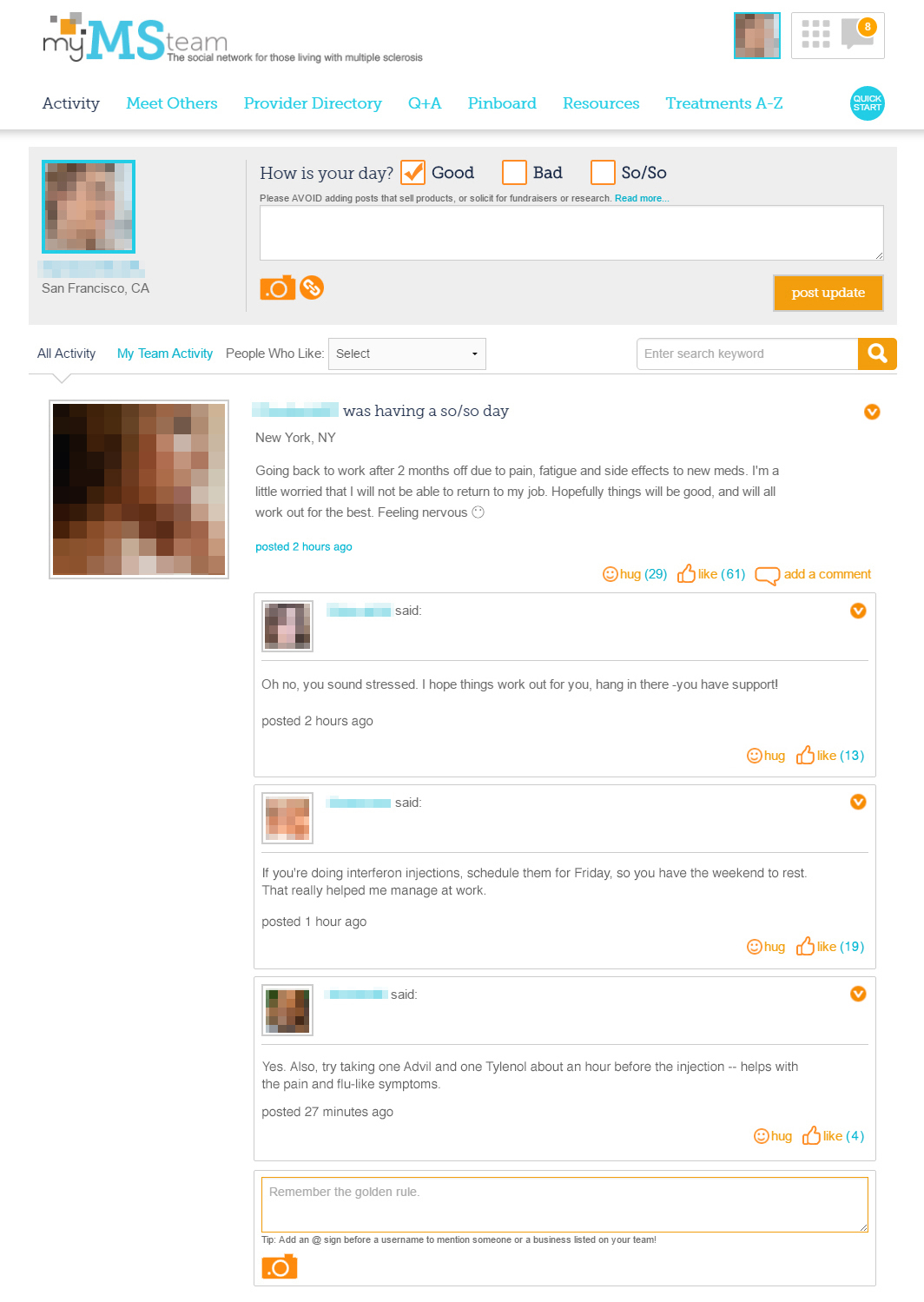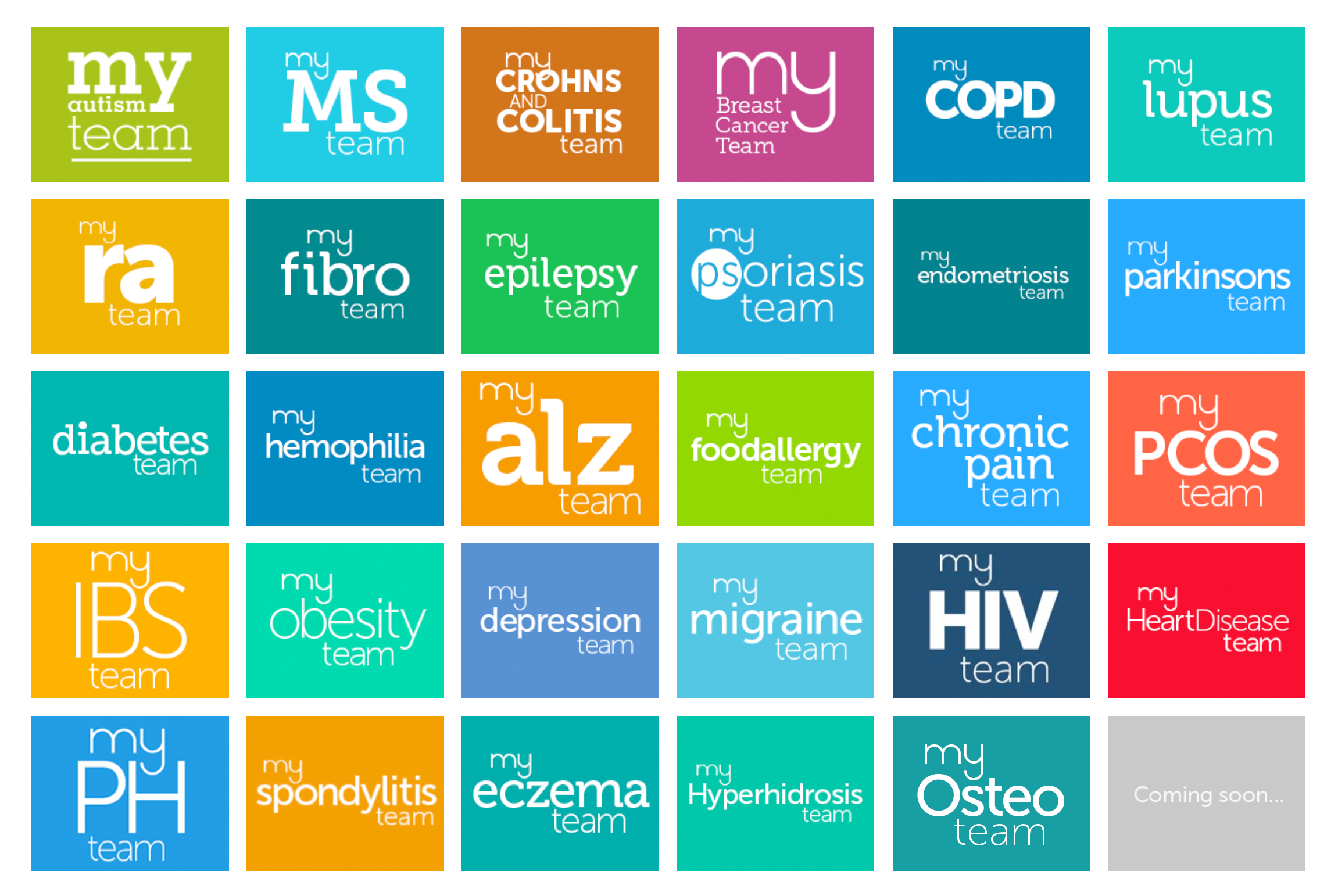Imagine if one day you received the unfortunate news that you had a chronic disease or condition. It could be diabetes, ALS, cancer, whatever you know the most about. Think about how you would feel. Then think about what you would want to do next. Would you try to find a new doctor? Would you scramble online and try to learn more about your chronic disease? Where you would you begin to search, and what would you try to find? Or would you simply look for a shoulder to cry on to get through that first day?
Many of the world’s greatest products and companies were born out of an initial insight, an observation of a need or gap that exists in the market or in people. The insight for the iPhone was the potential for a convergence of devices into one convenient tool. The insight for Uber was that people wanted the convenience of a taxi with the mobility of a personal car. The insight for MyHealthTeams, which you may have discovered from the thought experiment in the previous paragraph, was that people with chronic diseases wanted communities where they could learn about their conditions and find emotional/practical support beyond what doctors and generic health websites could provide.
Using that insight as its core foundation, MyHealthTeams has become a platform of 29 social networks each specializing in a particular condition (eg MyParkinsonsTeam, MyEpilepsyTeam, etc.), where people from all types of backgrounds can come together to discuss various topics surrounding their chronic disease. I talked to co-founder and COO Mary Ray to learn more about MyHealthTeams’ initial insight, the discussions that occur on its networks every day, and the impact the platform has had on both patients and the people around them.
How did the idea for MyHealthTeams originally get started?
Mary Ray: I’ve been in the consumer tech space since the late 90s, and in general I get inspiration from whatever the needs of friends and family are. It occurred to me and my co-founder that one area that was sorely lacking any kind of cool consumer tech was healthcare. I wasn’t trying to get into healthcare, but that was where the opportunity/need was, particularly for chronic illnesses. When we looked around, we realized that we knew someone who had a chronic condition or was actually caring for someone with a disease. When you look at the data, 1 in 2 Americans have a chronic condition, that’s just the facts. So there was an opportunity there, and we started interviewing hundreds of people with various diseases or those who were caring for somebody with one.
What we heard time and time again, almost like a broken record regardless of the condition, was that once someone was diagnosed with a chronic disease, that person would go home, go to Google, and then search like crazy for anything that could help them make sense of this new thing in their life. They’d then go through basically the stages of grief, and once they made it through that they started to self-identify with that disease as part of who they are.
Once we saw this pattern, we realized that a lot of the elements out there, be it a nonprofit organization, Wikipedia, or WebMD, were all good at providing information but not a sense of connection to what they were facing. When you start empathizing with what these folks are facing, we thought, “How can we put these people in touch with each other?” The initial thought was that maybe they need to connect with each other to find the best providers, but that’s very shortsighted. Really what people wanted was to find someone just like themselves. Something like “I’m 30 years old, I’m thinking about having a family, but my oncologist is telling me that my treatment plan might involve chemotherapy.” That’s how this idea came about.
The first prototype was MyAutismTeam. That was a social network for parents of kids on the spectrum. We started in the Bay Area, did a couple of in-person focus groups before we wrote one line of code, got their response, iterated on it, put the platform out there, iterated further, etc. Eventually we wanted to test out other conditions, and six years later we now have 29 social networks with 1.3 million members across those social networks.

In the Photo: A MyHealthTeams conversation. Photo Credit: MyHealthTeams
MyHealthTeams is about providing social networks, what kinds of conversations are held on those networks?
MR: There’s a range, and if you look at MyHealthTeams.com you’ll see that we have these very specifically branded social networks, because people identify with a particular disease. Topics tend to include the disease itself, or the “burden of the disease” as I call it, but also the social and economic burden as well as treatment and life hacks. Everybody wants a shortcut somehow, especially when you’re managing a chronic disease where you have to deal with symptoms and side effects of treatments. An example would be “hey, does anybody have any tips on how to mitigate these flu-like symptoms from this treatment for multiple sclerosis?” What we were able to do with MyMSTeam, which has over 100,000 members and is the largest social network in the world for people with MS, is crowdsource all the information and boil it down to a six-step ritual of how people can mitigate these really harsh symptoms from this particular treatment. It was amazing to see this from a data standpoint, because it illustrates the way in which the conversations happen as well as how we manifest those conversations and share the wisdom of the crowd.
Other things that people talk about include the dad on the MyCOPDTeam who’s saying “how am I going to get this oxygen tank down the aisle when I walk my daughter down the aisle for her wedding?” That’s not what you’re going to talk about with your doctor necessarily, but someone might have a solution like a mini-dolly or a special backpack. Or maybe on MyALZTeam a caregiver who’s a 45 year old woman of 120 pounds asking “how can I get my dad from his bed to the bathroom?” and someone answering “I use this pizza serving tool”. Are you going to get that advice from your doctor? Probably not.
Also, daily wins are big, like “today I was able to take a shower without running out of breath” and everybody celebrates that win. Those are the kinds of conversations across the social networks.
It’s really cool to see such a wide spectrum of conversation and stories on MyHealthTeams.
MR: CS Lewis has this great quote, basically to the effect of sometimes strangers feel closer than friends and family. In the case of MyHealthTeams it’s true. People don’t necessarily come here with an embedded circle of friends and family. They come with one thing in common, the disease they share or the circumstances of having to care for somebody with the condition.

In the Photo: The MyHealthTeams social networks. Photo Credit: MyHealthTeams
What kind of impact has MyHealthTeams had on people, either quantitatively or qualitatively?
MR: There’s this incredibly growing body of research that shows that the stronger social ties you have, the more likely you are to better manage your chronic disease. We believe that an informed community is a healthier community. The more you know, the stronger you’re going to be. I don’t have quantitative figures specific to our community, but there is this evidence out there suggesting that with ties of support patients will be healthier. We do what we do because we believe that the more people learn from each other and learn from each others’ experiences, the better they’ll be able to have perspective, ask the right questions to their doctors, and maybe even adhere to their own treatment better.
Qualitatively, I can tell you there’s not a day that goes by where I don’t get a note or email saying how much MyHealthTeams has changed someone’s life. We have a MyDepressionTeam, and people are feeling less alienated on the platform. They feel like people understand them. And when you’re feeling understood, that validation goes a long way. The reason why a lot of people who are working at the company are here is because they know the impact that they are producing daily. There’s tons of qualitative stuff out there suggesting we’re doing good stuff. We put out posters at conferences based on the crowdsourced insights that we get to help benefit the overall community, and I can even say that some of our work has impacted the way in which some companies develop their treatments and clinical trials.
In addition, the numbers that we have in terms of engagement, how frequently members of MyHealthTeams are coming back and the fact that they are using it via mobile, are definitely strong. And this speaks to the fact that people really do come to rely on us. Right now, nearly 70% of people access us on some kind of mobile device, 80% if you throw in tablets.
What do you believe the future of MyHealthTeams holds?
MR: Even with just our 29 social networks, 90% of the chronic condition population can be addressed by one of our networks. But that means there’s still 10% not addressed. We only have one site for cancer, so in that 10% we have any other cancer as well as 7,000 rare diseases. We’re also in eight countries right now that are English-speaking, so in terms of what could happen next, we can go deep in what we have, we can open up in a different language or another country, or we can go farther into the disease communities. There’s just so much more opportunity there.
I think the key for us is that we want to ensure that when it comes to healthcare, particularly with the chronic condition community, we’re always there in support of helping people better manage their condition so that they end up with better health outcomes. We also just want to have more people know about us. We can grow in so many different ways, we just want to make sure that we’re dialing this in right by not losing engagement and by becoming the habit for individuals by informing them, making them smarter about their disease, and hopefully helping the overall community at large along the way.










